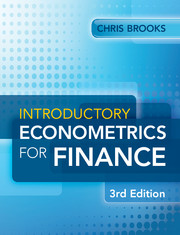Book contents
- Frontmatter
- Contents
- List of figures
- List of tables
- List of boxes
- List of screenshots
- Preface to the third edition
- Acknowledgements
- 1 Introduction
- 2 Mathematical and statistical foundations
- 3 A brief overview of the classical linear regression model
- 4 Further development and analysis of the classical linear regression model
- 5 Classical linear regression model assumptions and diagnostic tests
- 6 Univariate time series modelling and forecasting
- 7 Multivariate models
- 8 Modelling long-run relationships in finance
- 9 Modelling volatility and correlation
- 10 Switching models
- 11 Panel data
- 12 Limited dependent variable models
- 13 Simulation methods
- 14 Conducting empirical research or doing a project or dissertation in finance
- Appendix 1 Sources of data used in this book
- Appendix 2 Tables of statistical distributions
- Glossary
- References
- Index
11 - Panel data
- Frontmatter
- Contents
- List of figures
- List of tables
- List of boxes
- List of screenshots
- Preface to the third edition
- Acknowledgements
- 1 Introduction
- 2 Mathematical and statistical foundations
- 3 A brief overview of the classical linear regression model
- 4 Further development and analysis of the classical linear regression model
- 5 Classical linear regression model assumptions and diagnostic tests
- 6 Univariate time series modelling and forecasting
- 7 Multivariate models
- 8 Modelling long-run relationships in finance
- 9 Modelling volatility and correlation
- 10 Switching models
- 11 Panel data
- 12 Limited dependent variable models
- 13 Simulation methods
- 14 Conducting empirical research or doing a project or dissertation in finance
- Appendix 1 Sources of data used in this book
- Appendix 2 Tables of statistical distributions
- Glossary
- References
- Index
Summary
Learning outcomes
In this chapter, you will learn how to
• Describe the key features of panel data and outline the advantages and disadvantages of working with panels rather than other structures
• Explain the intuition behind seemingly unrelated regressions and propose examples of where they may be usefully employed
• Contrast the fixed effect and random effect approaches to panel model specification, determining which is the more appropriate in particular cases
• Estimate and interpret the results from panel unit root and cointegration tests
• Construct and estimate panel models in EViews
Introduction – what are panel techniques and why are they used?
The situation often arises in financial modelling where we have data comprising both time series and cross-sectional elements, and such a dataset would be known as a panel of data or longitudinal data. A panel of data will embody information across both time and space. Importantly, a panel keeps the same individuals or objects (henceforth we will call these ‘entities’) and measures some quantity about them over time. This chapter will present and discuss the important features of panel analysis, and will describe the techniques used to model such data.
Information
- Type
- Chapter
- Information
- Introductory Econometrics for Finance , pp. 526 - 558Publisher: Cambridge University PressPrint publication year: 2014
Accessibility standard: Unknown
Why this information is here
This section outlines the accessibility features of this content - including support for screen readers, full keyboard navigation and high-contrast display options. This may not be relevant for you.Accessibility Information
- 1
- Cited by
